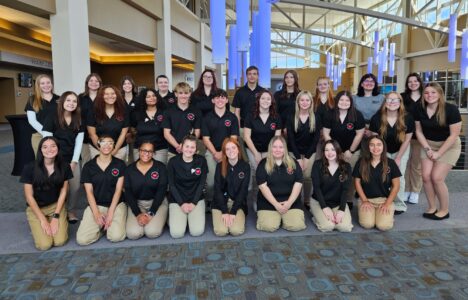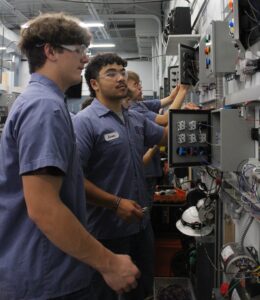Norfolk Southern takes train inspections to the next level

Stephanie Elverd INSPECTION SYSTEM — Norfolk Southern deployed its first Digital Train Inspection Portal in Leetonia along state Route 164 on Wednesday. The portal has 38 high-resolution cameras that capture more than 1,000 images of each rail car as a train passes through at full speed. Artificial intelligence then analyzes the images to detect potential defects in practically real time.
LEETONIA — During Alan Shaw’s first sit down interview with local media in March following the Feb. 3 train derailment, the Norfolk Southern CEO said the railroad would continue to invest in technology and talked about a machine-visioning inspection portal that was in development. Shaw pledged that when the innovative inspection tool was ready to be implemented, it would be done so “just outside of East Palestine.”
On Wednesday, Shaw made good on that promise when Norfolk Southern deployed its first Digital Train Inspection Portal in Leetonia, just 11 miles from the derailment site.
“We are a safe railroad, and we’re going above and beyond to become even safer,” said Shaw. “These new portals combine advanced technology with human expertise, giving our people and the public further confidence in Norfolk Southern’s safe operations. It’s all part of our promise to become the gold standard of safety in the rail industry.”
The portal was developed in concert with the Georgia Tech Research Institution and uses advanced machine-visioning technology and artificial intelligence to find potential defects on moving trains.
“This is technology that is truly next generation that supercharges Norfolk Southern’s safety infrastructure,” said Norfolk Southern Chief Data Scientist Mabby Amouie. “There are three components that make up this state-of-the-art technology. There is a hardware component, there is a software component and then it’s followed by people.”
While the technology and science behind the portal is complex, the concept is simple. As a train passes through the portal — which resembles a modern highway tollbooth housed in a tunnel-like structure with high-powered stadium lighting — 38 high-resolution cameras capture more than 1,000 images of each rail car from different angles for a full 360-degree view while the train is at full speed. AI then analyzes the images for potential defects in practical real time. If a defect is detected, the information is relayed to the network operating center and passed on to train crews in a matter of minutes. Depending on that information and specific suspected defect, proper safety protocol is put into action, and hopefully, a potential disaster prevented.
“This will pick visual defects. Think of components like a bent sill step. Think of a couplers defect. Think of visual components,” Amoiue said.
“Railcars are made up of a lot of different parts that are subject to wear and tear over time and because of that we inspect our cars and we do that very frequently,” Amouie said. “The inspection process involves two people walking along the train, looking at the different components and accessing them visually. Some of these components are in hard-to-see areas and you are also susceptible to adverse weather conditions. The beauty of this technology is that these ultra-high-resolution cameras and very powerful stadium lighting are housed in the tunnels which are not susceptible to weather conditions, so rain and snow are not going to have an impact. All this helps us find defects faster and sooner.”
While Georgia Tech engineered the hardware and provided the machine-visioning expertise to capture the images, Norfolk Southern’s data science/artificial intelligence and mechanical teams developed the software.
“Not only is it important to take those 1,000 pictures per railcar, it is important to have an AI algorithm to find defects and it is critical to have an AI algorithm that has a high defect detection rate with low false alarms,” Amouie said. “Really, at Norfolk Southern our data science AI teams and mechanical teams. They cracked the code, and this is why this is truly a next generation technology with advanced AI algorithms on top of it.
Amouie stressed the portal is meant to augment, not replace, crew inspection of trains, nor is it meant to replace hotbox detectors that track components thermally, calling the portal “another level of safety and confidence.”
Norfolk Southern’s John Fleps said the railroad plans to install 17 portals along its nearly 19,000-miles of track — one every thousand miles or less — by early 2025. Currently five portals are under construction and near completion along the eastern United States.
“We want to see a rail car traverse one of these portals every thousand miles, and if there are little pockets on the line that aren’t seeing that frequency, we are going to continue to invest and ultimately continue to drive that number to zero,” Fleps said.
The portals have been in development for years, but were fast-tracked following February’s rail disaster. Originally, the portal’s pilot site was located in Atlanta near the corporation’s headquarters, but the decision was made to launch the prototype in Columbiana County.
“In the wake of EP it made sense to come up here. Another justifying factor was that this is our high-density line segment across our entire network,” Fleps explained. “There are upward of 80 to 90 trains a day that traverse this line. This is our premier corridor. It was an easy decision when we had a chance to rethink it coming out of EP.”
Fleps and Amouie stopped short of saying the portal would have prevented the derailment in East Palestine.
“We will use this technology to examine every component we can see which includes a wheel bearing. And the preliminary investigation from the NTSB indicates a hot wheel bearing failed in East Palestine,” Fleps said “Our protection system we use to protect against that condition is more than 900 wayside detectors and an additional 250 additional since the accident. This will just be another level of safety on top of what is a strong and enhanced wayside detectors network that we’re approving right now. On average, our detectors are 13.9 miles apart, which is an industry-leading gap spacing and we are committed to no distance greater than 15 miles.”
The portals and supplemental hotbox detectors are part of a $50 million investment by Norfolk Southern in the wake of the derailment. That investment also includes other wayside equipment, including acoustic detectors that would have picked up the likely cause of the East Palestine derailment, as well as expanding employee training and advancing technology to survey the integrity of infrastructure — track, bridges and tunnels on the Norfolk Southern network.
“We use data and similar technology and the data science team to inspect tracks with digital technology. We also have a competitive strength with our autonomous track inspection system that is mounted to locomotives inspecting the track while the train is pulling freight and again passing that information on to a team that can act on and provide another layer of safety.”
Norfolk Southern became the first North American freight railroad to develop and deploy the autonomous track inspection system in 2020 and Felps said the railroad is currently working on technology to enhance “train operation in the cab of locomotives.”
Ultimately, Fleps said Norfolk Southern has a duty of safety to the communities its trains travel through and are using data-driven technology and innovation to fulfill that obligation.
“The communities we operate through expect to operate every single day, 365 days a year, year after year, without incident, and that’s our goal,’ he said. “An incident like East Palestine is incredibly rare, but one is too many and we are committed to having something like that not happen again. We are investing in technology, we are investing in our people and investing in our infrastructure to help to take that safety to another level.”





